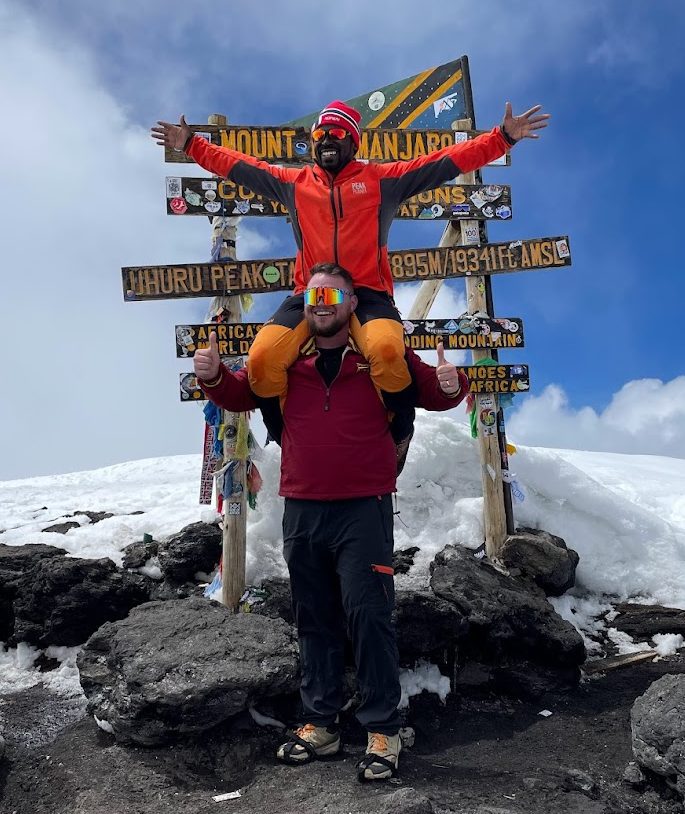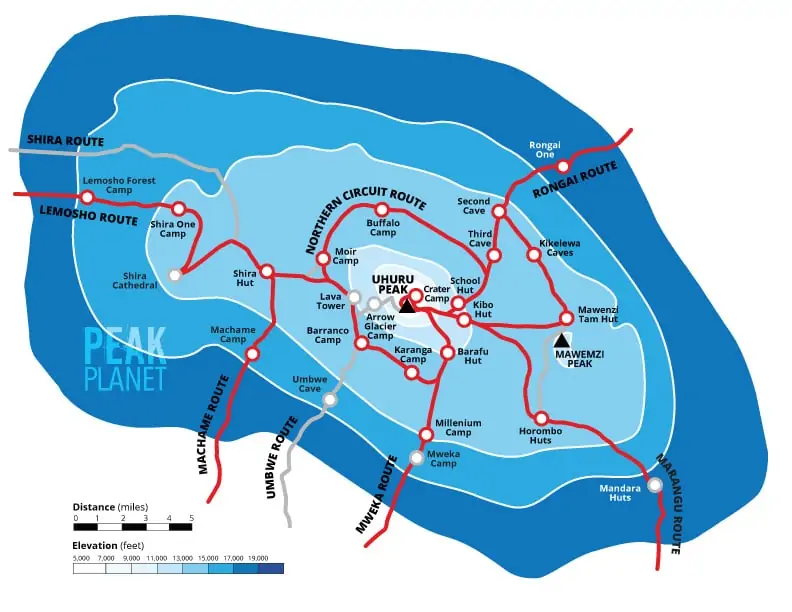
If you’re considering a Kilimanjaro climb, you might be curious as to whether there is a path of least resistance – a way of somehow avoiding confrontation with a challenging scramble or a harrowing clash with acute mountain sickness (AMS). The good news is that most of Peak Planet’s scenic climbing routes require little to no scrambling, while none of the six main climbing routes require any technical mountaineering skills. The less good news is that none of the routes guarantee complete protection from AMS, but some do inherently carry better odds of avoiding AMS symptoms or you might experience relatively minor symptoms.
We will look at some of the Kilimanjaro constants as well as some of its variables, and from that information derive how the route and the duration of the climb you select has a direct impact on your odds of success.
KILIMANJARO – A PERSONALITY LIKE NO OTHER
Climbing Mount Kilimanjaro is a one-of-a-kind experience, incomparable to any other. In only days, your journey to the “Roof of Africa” will take you from the warm, lush farms and villages that that comprise the Cultivation Zone through the wet, densely vegetated Rainforest Zone. If you’re lucky, you might spot a family of Blue or Colobus monkeys dancing through the trees above you. From there, you’ll traverse the Heather and Moorland Zones, where the rich greenery of the rainforest shrouding the trail gives way almost suddenly to green(ish) and brown knee- and waist-high grasses, as well as concentrations of the iconic, alien Dendrosenecio kilimanjari, which exist only on the slopes of Kilimanjaro. Wild temperature fluctuations and progressively rockier trail conditions characterize these zones, which take you to approximately 13,000 feet or 4,000 meters above sea level. Here, the Highland Desert Zone begins, defined by seemingly endless barren fields speckled with pea- to car-sized chunks of volcanic rock – echoes of the now dormant volcano’s turbulent past. The plant life here is sparse, the air dry, and you might even find yourself trekking among the clouds. From 16,000 feet (4,900 meters) to the summit, you will ascend in the Arctic Zone over loose gravel, snow, and even ice. Below freezing temperatures and almost half the oxygen we breathe at sea level make the Arctic Zone an uncomfortable place to exist.
ACUTE MOUNTAIN SICKNESS
There’s no guarantee when or if AMS will become part of your journey, but statistically more than 75% of climbers will experience some form of AMS symptoms above 9,000 feet (2,700 meters). Typically manifesting in bouts of nausea and intermittent headaches, acute mountain sickness is curiously impartial to a climber’s level of fitness. Loss of appetite, shortness of breath, and difficulty sleeping are commonly experienced with more prolonged exposure to high altitudes, while the most severe cases of AMS can lead to potentially fatal cerebral and pulmonary edema. Rest assured, there are ways to mitigate the impact and severity of altitude sickness, and Peak Planet throws the proverbial high-altitude climbing handbook at it.
PEAK PLANET’S COMMITMENT TO SAFETY
The Peak Planet website is a virtual treasure trove of information, and where there are variables, Peak Planet goes above and beyond to inform every decision you will need to make when it comes to planning your trek.
THE BEST TIMES TO CLIMB
The conditions you’ll encounter on the mountain are mentioned for good reason. There is an additional layer to consider when you plan your trip, which are the seasons of Kilimanjaro. There are four seasons on Kili, but not in the traditional sense – a short rainy season (November), a long rainy season (the end of March to the beginning of June), a short dry season (January and February) and a long dry season (July through October). The best times to climb are during either of the two dry seasons. They tend to be the busier of the seasons as you might expect, but I found the jovial, high-energy atmosphere of camp to be a needed morale boost. There is truth to the expression that there is strength in numbers.
ACUTE MOUNTAIN SICKNESS MITIGATION
Peak Planet’s emphasis on climber safety is unparalleled, and they employ every tried-and-true high-altitude climbing tactic to ensure a safe and successful climb. Each and every Peak Planet guide is a certified Wilderness First Responder who conducts twice daily health checks for each climber. They and their support team also carry emergency oxygen for more serious cases of altitude sickness should the need arise.
Another hugely important strategy utilized by the guides is to regulate the rate of ascent. Expect a controlled, slow and steady climb from the onset. “Pole pole” (pronounced “po-lay po-lay, which is Swahili for “slowly slowly”) is an expression each and every climber will become quickly familiar with. It will, at first, seem almost unnatural how slow those early steps are, but once you reach the point in the climb where exhaustion and symptoms of AMS start to become factors, it becomes clear why giving your body time to acclimate is of utmost importance.
In addition to climbing slowly, you will also “climb high and sleep low” to help kick-start the body’s adjustment to what lies ahead. At the end of each day, you’ll go on a short acclimatization hike, climbing just a few hundred feet higher than your camp before retreating to rest for the night. The body will then begin its task of producing more oxygen-binding red blood cells to keep your body functioning as you continue your journey upward.
One other alternative you can quite literally have in your back pocket is of the prophylactic variety. Peak Planet recommends discussing with your doctor the use of Diamox as a means of preventing and treating AMS. Worth noting, Peak Planet nor their guides are not able to recommend if you should or should not use Diamox, this is only a decision that can be made with proper review of each person’s medical history done by your doctor. So you’ll want to make sure you discuss this with your doctor and to get your prescription at home and bring it with you if it determine that Diamox is right for you. Diamox is also a diuretic, so plan on drinking a lot of water in order to stay hydrated, because you will lose it almost as quickly!
TIME IS ON YOUR SIDE
Above all else, the body needs time to acclimate. Each of the time-tested strategies discussed above play a vital role in ensuring a safe, successful, and enjoyable climb, but the strategy with arguably the greatest benefit is to select the longest possible route that works within your constraints. Peak Planet offers routes between six and twelve days in length, with the four options for group climbs which spend between 7 and 9 days on the mountain. Simply put, the longer the duration of the climb, the more time that’s built in for acclimatization, and the less likely you are to be hampered by AMS symptoms.

CHOOSING THE RIGHT ROUTE FOR YOU
Peak Planet does a truly remarkable job of breaking down each available route on their website. Each route is broken down by day, and within each day they highlight the landmarks you can expect to see, the elevation you’ll be climbing to, and what the expected trail conditions are. They also include statistics for each day’s duration, the distance you’ll cover from camp to camp, and the total elevation gained and/or lost. There are even videos of each route explaining in further detail what you can expect from each day AND downloadable itineraries with all of that information and more! Do a bit of light research, pick the right route for you with all of this information in mind, and let Peak Planet guide you on your quest to the top of one of the world’s most iconic natural wonders!


